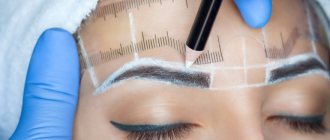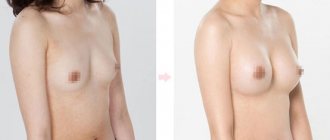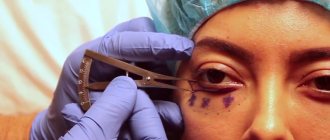What are dentures filled with?
The implant looks like a transparent round-shaped bag; it is made of silicone.
This polymeric substance is also poured into the medical device in a jelly-like state. There is another content option - physical solution. These modifications have both advantages and disadvantages. The downside of salty liquid is gurgling when moving. The advantages are affordable price and safety: if it gets into tissue, there will be no harm. The advantage of a jelly-like substance is that the gel does not spread when the shell breaks. Nowadays durable models are produced; the surface is damaged in rare cases. There is also a negative side to this. When the silicone leaks out, the breast must be operated on again.
Experts advise not to save money and choose quality products that have an unlimited shelf life.
Is it possible to avoid scars after surgery?
“Just as after any cut a mark is formed on the body, so after plastic surgery a scar remains. Moreover, any scar has several stages of its development. At first it is red, over time it begins to turn white until it turns into a thin stripe. The interval between these stages can last for one and a half years. Therefore, to the question of whether scars can be avoided, the answer is negative. However, there is good news. The surgeon can make the scar invisible to others. For this purpose, incisions must be made in hidden areas. Do not forget that there are modern correction methods that help the scar become less noticeable. These include scar camouflage, laser resurfacing, and so on.”
Which forms of implants are better?
Previously, only round samples were produced. Their purpose is to give the bust a voluminous, raised appearance.
Now they produce other models similar to a drop. These types are more expensive, but they hardly show their presence, since the mammary glands remain smooth and natural. The disadvantages of anatomical options include possible displacement.
Regardless of the configuration of the medical device, you can understand that the surgeon has worked on the body. The signs are:
- incorrect proportions when a thin girl has large breasts;
- lack of symmetry or too smooth appearance of the nipples;
- when a woman lies down, the bust remains in the same standing position;
- the mammary glands are more elastic to the touch, sometimes you feel cool;
- the bare chest does not fall, despite the force of gravity, the upper part looks like a ball;
- scars on the body may indicate surgery.
If the patient is concerned about how silicone breasts look, natural or unnatural, then it is better to install teardrop-shaped endoprostheses.
Installation methods
Mammoplasty is performed in different variations. Surgeons determine the optimal location for the incision based on the characteristics of the individual patient:
- Above the pectoralis major muscle, in the nipple area. It is believed that this method is the least traumatic and the body recovers quickly. The disadvantage is that sometimes the edges of the prosthesis are visible. When it is heavy, the new forms slowly sag over time.
- Under the fascia of the pectoral muscle. Compared to the first type, it allows you to securely fix the silicone implant.
- Between the pectoral muscles. It makes it possible to significantly increase the volume of the bust and hides the outline of the polymer product. The plus is that the female form is at its best.
- The integument is cut under the breast. Applicable for salt species, the positive and negative points are similar to the first method.
You should not be afraid of scars; the level of modern medicine allows you to operate without the scars being noticeable. It’s worse if health problems begin after the intervention.
Breast surgery and breastfeeding
During pregnancy, many women who have undergone breast surgery (breast surgery, breast reduction or enlargement, implantation, lift) worry about how it may affect breastfeeding.
Can a woman breastfeed after surgery?
Often, women who are about to undergo breast surgery are told that either there will be no problems with breastfeeding their future children, or that this is impossible in principle. Such extremes significantly affect future breastfeeding.
Most mothers who have previously had some kind of breast surgery can breastfeed their children, providing the full nutritional needs of the children. Some women need special measures to stimulate lactation. In some cases, there is a need to introduce supplementary feeding if other causes of lack of milk are excluded. It is impossible to determine in advance which of these groups a particular woman will fall into.
Before any breast surgery, it is important to discuss the prospect of breastfeeding with the surgeon, and the specialist will select the appropriate technique and manipulations to be performed during the operation to preserve the possibility of breastfeeding.
It matters how the tissue is affected during surgery.
Surgeons often perform a section along the edge of the areola - the so-called periareolar section. Such an incision in many cases causes insufficient milk production in lactating women.
This is due to the fact that such a section may damage the nerve fibers involved in the reflex arc that ensures the processes of milk production and separation. The degree of damage to nerve fibers during a periareolar section depends on whether it was carried out along the entire edge of the areola or only part of it. And also whether the nipple and areola were moved during the operation. Usually a section in this part of the chest is done because the scar from the operation “looks more beautiful” here. But such an incision has more postoperative consequences, in particular, the pain from such an incision is usually described as more severe.
Typically, breast enlargement does not have a negative impact on further feeding, because... In modern operations, the placement of implants does not affect the gland tissue itself. They are located directly behind the gland on the pectoralis major muscle or under the pectoralis major muscle.
If a woman has undergone breast augmentation surgery, the extent to which the nerves and ducts were excised also matters. If they were slightly affected, then there should be no problems with the amount of milk. It is important to consider that if mammoplasty was performed due to insufficiency of glandular tissue (breast hypoplasia), then the problem of lack of milk is associated with it rather than with the operation.
Breast reduction surgery This is especially likely if the nipple was moved to a new location during mammoplasty, as this leads to disruption of the innervation of the nipple and areola. It also affects how much the mammary gland and milk ducts were affected during the operation. However, nerves can grow back and re-establish nerve connections, albeit slowly, and glandular tissue may develop slightly during pregnancy.
In the case of a mastectomy (amputation of one of the mammary glands), even due to cancer, a woman has the opportunity to feed her child with the second breast. With a double mastectomy, breastfeeding is unfortunately not possible.
Non-surgical methods: breast lift with threads (ligature plasty), mesotherapy, myostimulation, provided the procedures are successful, do not affect the glandular tissue and areola, so breastfeeding after these procedures is possible in full.
Often, women after breast surgery are worried about the occurrence of various types of milk stagnation (lactostasis, mastitis). In most cases, operations have no effect on the development of congestion. If during the operation there was damage to the ducts or scarring after the operation, then the woman needs to pay special attention to the organization of breastfeeding and proper attachment to the breast, since in these cases there may indeed be problems with the outflow of milk. Treatment for lactostasis in a woman with operated breasts is exactly the same as in all other cases (unless there are specific recommendations from the surgeon).
For a woman who has undergone breast surgery and is preparing to become a mother, the best option is to find a lactation consultant in your city in advance who will help prepare for the upcoming feeding and provide the necessary support after childbirth. We will be happy to help you make breastfeeding a pleasure.
Evgenia Simak, Alena Lukyanchuk, lactation consultants
Is silicone implantation safe?
Manipulation with a scalpel always carries a risk of worsening the condition. No doctor guarantees a favorable outcome, since complications are likely:
- miscalculations in the dose of anesthetic substance during anesthesia;
- the body rejects the foreign element, and then it is difficult for the implant to take root;
- during installation, the infection is brought inside and inflammation begins;
- After the operation, pain occurs, rehabilitation lasts up to six months, during which time you will have to pay for treatment;
- large hematomas due to the accumulation of blood under the skin are removed surgically;
- in 5% of women, nipples lose sensitivity;
- it is impossible to feed a newborn if the operation affected the areola and the milk ducts were damaged;
- the implant shell is sometimes damaged during an accident, fall or other types of injuries;
- There are many cases when the endoprosthesis is displaced.
All operations that are performed repeatedly cost more. When explantation is done, the skin needs to be tightened, which leaves large scars on the chest. There are negative aspects of mammoplasty - which surgeons are silent about.
In the 80s, the famous American implant manufacturer paid multimillion-dollar lawsuits from women who had mammoplasty. The victims experienced serious health problems due to the fact that the prosthetic shells were leaking silicone. The substance spread throughout the tissues, causing deformation, swelling, pain, and severe diseases of the mammary glands.
The public was alarmed, doctors said that neurological consequences and malignancies appeared due to the implants. Then in the 90s, such operations were banned in the states for almost a decade.
In 1999, several independent American scientists gave reports and confirmed that silicone does not cause cancer. The researchers noted that the condition of operated patients worsens as a result of:
- postoperative complications;
- intolerance to polymer substances;
- in case of violation of the production and installation technology of a silicone product.
However, in 2012, Ukrainian scientists published a study on the negative effects of polymers used in medicine. Facts confirm that over time, toxic microparticles are formed due to silicone prostheses, causing the body to be gradually poisoned. This is fraught with damage to the lungs, immune system, nervous system, as well as the liver, skin, and the appearance of allergies.
Long-term experiments of the Russian scientist Anatoly Borisovich Shekhter have proven that implants with a smooth surface cause chronic inflammation in the body, since the gel comes out through the shell. That is why textured products are safer.
The polymer can tear imperceptibly, but the spreading of the liquid is not felt. Therefore, experienced surgeons advise clients to undergo an MRI every three years.
According to surgeons, the shell of a modern endoprosthesis is very durable. In addition, there are harmless fillers. Therefore, women can live in peace; silicone breasts in old age will not cause inconvenience.
The manufacturer of quality products promises a lifetime service life. It is recommended to check the availability of the certificate.
Most women undergo surgery after having children. Partly because, having undergone plastic surgery, you supposedly cannot feed the baby. Many people are confused by the possible problems of silicone breasts after childbirth.
Practicing surgeons answer that prosthetics do not interfere with childbirth. The only condition is that the incision must pass under the mammary gland.
Silicone does not get into milk because it does not dissolve in liquid. Therefore, implants are not dangerous for a newborn. In addition, certain drugs that are prescribed for colic in infants contain this substance. Implantation does not harm pregnant women.
There is a possibility that the skin will sag after breastfeeding ends, since the bust initially increases in size. In such cases, new forms require special care: you need to frequently moisturize the skin and wear supportive underwear. In addition, changes in the size of the glands lead to the loss of the shape given by the prosthesis or its displacement. It is often necessary to resort to a lift after weaning the baby.
Secrets of breastfeeding after mammoplasty
“After breast augmentation surgery, you will not be able to breastfeed.” “And silicone gets into the milk - this is very harmful to the baby’s health.” “What is more important to you: breasts or children?” Probably every girl who decides to have mammoplasty hears similar statements. And this poor girl has to explain the following things to everyone:
1. Breast augmentation surgery does not affect the possibility of breastfeeding.
Women who have undergone mammoplasty successfully breastfeed their children. The operation does not affect breastfeeding in any way. Milk is produced in full, and the breast is in no way inferior in functionality to natural breasts. Unfortunately, complications sometimes occur after surgery. If the operation is not performed by a sufficiently qualified doctor, then the patient may experience mastitis - inflammation of the milk ducts - and this in turn can lead to problems with breastfeeding. In order to avoid negative consequences, the operation should be performed only by a highly qualified surgeon with extensive experience in mammoplasty.
2. Silicone cannot pass into breast milk.
Scientific and medical studies have proven that silicone from breast implants cannot in any way pass into mother's milk. The latest generations of implants are made in such a way that even in the event of an unexpected rupture of the shell, the silicone will not lose its shape. In addition, silicone does not dissolve in water and other physiological fluids, which means it physically cannot get into small vessels and affect the quality of breast milk.
3. The main thing in this matter is to prepare properly
Every expectant mother prepares for breastfeeding. Regardless of whether there has been plastic surgery or not, to facilitate the feeding process and reduce discomfort to the maximum, appropriate preparation is necessary. It’s just that girls with breast implants need to take this issue more seriously. And while still pregnant, go to a breastfeeding specialist. He will clearly explain in what position and how to feed the child correctly if you have implants. And what measures need to be taken to properly establish lactation.
We hope that in this article we have answered the basic questions about breastfeeding a baby for girls who have undergone surgery to enlarge or correct the shape of their breasts. You can read more about the effect of silicone implants on pregnancy in general in our article.
Find out more about MENTOR breast implants on the official website of the distributor in Russia MENTOR4YOU.ru
You may also be interested in other materials on the topic of Breast augmentation.
Video breast augmentation Photo breast augmentation Reviews after breast augmentation Articles about breast augmentation
Reviews from women who have undergone surgery
The sensations from the breast are as if they were your own. Two years later I don’t even remember having implants inserted. I was lucky because the operation took place at a young age. A large bust takes its toll, you need to strengthen your back, you can’t sleep on your stomach, but these are minor things. The main thing is that I am satisfied with everything, I began to feel much more confident, and immediately after the operation I met my future husband. I advise all girls who suffer from small size to solve the problem in this way. The price is worth getting rid of suffering and gaining new emotions.
I placed implants with a volume of 325 ml, an incision was made under the muscle. After the operation there was unbearable pain. I cried and took pills all week. Of course, over time the bad things were forgotten, we had to be patient. For about six months I felt a foreign body inside me. I couldn’t sleep on my stomach; I had increased sensitivity. But then everything went away, so girls who really want to do it, I recommend it.
I was operated on in 2004. The scars lightened and became thinner, five years later, there were no complications. I was afraid of oncology or thinning of the membrane, but everything is fine. Breasts look great in clothes, but without them it is immediately clear that they are artificial. If you touch it, you feel cool. It’s also embarrassing that when I lose weight, the edges of the endoprostheses are visible, the skin bunches up a little in some positions. Now I have gained 9 kg, and all the problems have disappeared, nothing is noticeable. I have never regretted that I decided to take such a step.
Pregnancy and breastfeeding after breast augmentation
Augmentation mammoplasty is one of the most popular plastic surgeries all over the world, thanks to which millions of women have the opportunity to become not only more beautiful and attractive, but also more self-confident. And although breast augmentation surgery is one of the most popular and at the same time safe for health, preparation for it raises many questions.
One of the most exciting questions regarding this operation today is the question: when is it better to perform breast augmentation surgery before or after pregnancy, and what effect will mammoplasty have on breastfeeding? These questions are asked by every patient of childbearing age and this is not surprising.
Breast enlargement and pregnancy
And although there is no clear answer to the question of when it is better to have breast enlargement surgery before or after pregnancy, mammologists and plastic surgeons agree that breast enlargement surgery is still better done after pregnancy and childbirth. This is due to the fact that during pregnancy and after it, the breasts repeatedly change their shape and often lose their attractiveness, which ultimately leads to very disappointing results. All these consequences can also befall breasts that were enlarged before pregnancy, and it is likely that you will have to resort to repeat breast augmentation surgery to correct them.
Among other things, the presence of implants requires a woman to pay close attention to her breasts during pregnancy and if even minor pain appears in the breast or nipple area, you should definitely inform your doctor about this for additional examination.
Breast augmentation and feeding
Another equally common question regarding breast augmentation is the question of the possibility of breastfeeding after this operation, and this is not surprising, because breastfeeding is not just a physiological process, it is also a special bond between mother and child. Breastfeeding is important for both the child and the mother - for the child, breastfeeding is a guarantee of security, and in the case of the mother, feeding forms a stable attachment to her child, which allows her to overcome all the difficulties associated with the period of infancy in the future. To summarize, I would like to say that breastfeeding is a very important function and therefore the concerns caused by such an operation as augmentation mammoplasty are very justified.
Due to the fact that breast augmentation surgery occurs without affecting the milk ducts, professionally performed mammoplasty and implant installation do not affect the most important physiological mechanisms that affect the feeding of the child. Therefore, in most cases, the answer to the question - is it possible to breastfeed after breast augmentation will be positive, but do not forget that any surgical intervention adds a number of features to both pregnancy and breastfeeding, including, for example, a decrease or complete loss of nipple sensitivity.
And although breast augmentation surgery does not have a negative effect on pregnancy and breastfeeding, we still advise you to postpone it and perform it after childbirth and breastfeeding. But if you nevertheless decide to undergo breast augmentation surgery before pregnancy and lactation, then we advise you to carefully and seriously approach the choice of a clinic and, in particular, a plastic surgeon who will perform this operation. The final result of the operation and whether the operation will have any negative impact on the body during pregnancy and breastfeeding directly depends on the professionalism of the plastic surgeon.
The clinic of Dr. Prikhodko employs only highly qualified specialists who have a fairly extensive amount of knowledge and many years of experience in performing plastic surgeries of any kind, including breast augmentation surgeries. Even at the stage of preparation for the operation, the plastic surgeons of our clinic will talk about all the nuances of breast augmentation and select the necessary technique for installing the implant, which will allow you to avoid various complications in the future, during pregnancy and breastfeeding.
We do everything possible to ensure that breast augmentation operations bring only joy and complete satisfaction to our patients!











